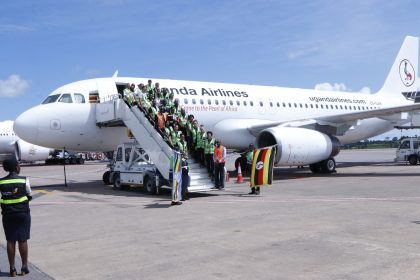2023 airline safety results validate IATA’s safety initiatives

Michael Wakabi
“Aviation places its highest priority on safety and that shows in the 2023 performance. Jet operations saw no hull losses or fatalities. 2023 also saw the lowest fatality risk and ‘all accident’ rate on record. A single fatal turboprop accident with 72 fatalities, however, reminds us that we can never take safety for granted. And two high profile accidents in the first month of 2024 show that, even if flying is among the safest activities a person can do, there is always room to improve. This is what we have done throughout our history. And we will continue to make flying ever safer,” IATA’s Director General, Willie Walsh, said in comments on the 2023 airline safety report.
The airline industry’s safety performance over the past 5 years validates safety initiatives that operators have embraced over the past few decades. As Walsh observes however, there cannot be a time to rest on one’s laurels.
The world’s airlines saw their safest year in 2023, registering no passenger jet loss of fatality.
According to the International Air Transport Associations (IATA aviation safety review for 2023, that was released this week, there were no hull losses or fatal accidents involving passenger jet aircraft in 2023. This was regardless of a 17 percent increase in aircraft movements by both jet and turboprop, to close the year at 37 million aircraft movements.
The only fly in the ointment was one fatal accident involving a turboprop aircraft, in which 72 people died. All the same, this was a reduction from five fatal accidents in 2022 and an improvement on the five-year average (2019-2023) which was five.
For Africa, the year capped a consecutive four-year period without a single passenger jet aircraft loss or fatal accident since 2020. Last year also stood out in a different way. It was the fifth time Africa was reporting zero fatal accidents involving turboprop aircraft in the period since 2015.
Africa’s accident rate improved from 10.88 per million sectors in 2022 to 6.38 in 2023. That was a huge leap forward from the 5-year average of 7.11 accidents per million sectors flown by African airlines.
Globally, the all-accident rate improved to 0.80 per million sectors in 2023 from 1.30 a year earlier, equating to one accident for every 1.26 million flights- the lowest rate in over a decade. This rate was better than the five-year (2019-2023) rolling average of 1.19, which equated to an average of one accident for every 880,293 flights.
The fatality risk also improved to 0.03 in 2023 from 0.11 in 2022 and 0.11 for the five years, 2019-2023.
“At this level of safety, on average a person would have to travel by air every day for 103,239 years to experience a fatal accident,” IATA says in the report.
These gains directly correlate to a number of industry initiatives such as the IATA Operational Safety Audit (IOSA). IATA says member airlines and non-member airlines on the IOSA register did not suffer a fatal accident in 2023. The IOSA Registry boasts 425 operators, 100 them non-IATA Members.
The all-accident rate for airlines on the IOSA registry in 2023 was 56pc better than the rate for non-IOSA airlines (0.69 vs.1.08).
According to IATA, the 2019-2023 average accident rate of IOSA airlines was 0.84 per million sectors which is almost three times better than the non-IOSA average of 2.24. It is perhaps no coincidence that the 19 accidents involving IOSA members did not result in any hull losses or fatalities.
“IOSA registered carriers recorded no hull losses or fatal accidents in 2023. Since 2005, the all-accident rate for airlines on the IOSA registry is almost three times better than for non-IOSA airlines. This sustained performance demonstrates that the implementation of global standards improves safety. With IOSA’s recent transition to a risk-based model focusing on pertinent safety risks while maintaining a baseline of safety, IOSA will become an even more powerful tool to help airlines and regulators to maintain and improve very high levels of safety performance,” said Walsh.
As part of its Focus Africa initiative, IATA last June, introduced the Collaborative Aviation Safety Improvement Programme (CASIP) to improve aviation safety in Africa. Through CASIP, states are being nudged to increase their implementation of the International Civil Aviation Organisation (ICAO) Standards and Recommended Practices (SARPs) for aviation safety. So far, only twelve of Africa’s 54 states meet the minimum threshold of implementing 75 per of ICAO’s SARPS, indicating a huge gap for improvement.
IATA reiterated the fact that safety can only be achieved through the collective pursuit of common goals or, a shared responsibility as they put it.
A strong safety culture within the aviation industry is essential for continuous improvement in all aspects of operations. Creating an environment that encourages the transparent and timely reporting of incidents and accidents is essential to be able to identify systemic issues and prevent future occurrences, the lobby said.
IATA highlighted ongoing initiatives to entrench a Safety Culture among airlines. In 2023, IATA introduced The Safety Leadership Charter, designed to reinforce organizational safety culture through airline executives committing to the eight IATA safety leadership principles. To date 45 airlines have signed the charter.
The second track involves “Encouraging States” to Provide Timely, Comprehensive and Public Accident Reports: An IATA analysis of accident investigations from 2018 to 2022 showed that just over half are investigated and published as prescribed by the Chicago Convention. The current shortfall in compliance prevents the aviation industry’s various stakeholders from accessing vital information that could significantly improve flight safety.
“Safety enhancements and the prevention of future accidents stem from learning from past incidents. For airlines, this means cultivating a robust safety culture where every employee feels accountable for safety and is motivated and expected to report safety-related information. For states, it involves providing timely, comprehensive, and public accident reports. Out of 226 accidents in the past six years, only 121 final accident reports have been made available. This shortfall is not only a blatant disregard for the Chicago Convention but also undermines the safety of our passengers and crew. Governments and their agencies must step up their efforts,” said Walsh.
Data Driven Approach
According to IATA, data for its annual safety report is collected through IATA’s Global Aviation Data Management (GADM) programme, the world’s most diverse aviation data exchange programme. Data captured in GADM databases comprises accident and incident reports, ground damage occurrences and flight data from more than 470 different industry participants.
“By analyzing data from over 100,000 flights each day, through GADM, IATA is tackling safety issues before they become problems and continuously improving safety. For example, we identified a significant rise in incidents in Global Navigation Satellite System (GNSS) interference which we are now addressing with the help of key regulators such as EASA,” said Walsh.

 Brussels Airlines to announce Nairobi service
Brussels Airlines to announce Nairobi service
 SITA promises enhanced travel experience after Materna acquisition
SITA promises enhanced travel experience after Materna acquisition
 Saudia’s 105 aircraft order stretches A320neo lead over rival Max
Saudia’s 105 aircraft order stretches A320neo lead over rival Max
 Boeing refuses to pay hackers $200 million for stolen Data
Boeing refuses to pay hackers $200 million for stolen Data
 Uganda-Tanzania announce date for second joint business forum
Uganda-Tanzania announce date for second joint business forum
 Uganda Airlines leased A320 arrives in Entebbe
Uganda Airlines leased A320 arrives in Entebbe
